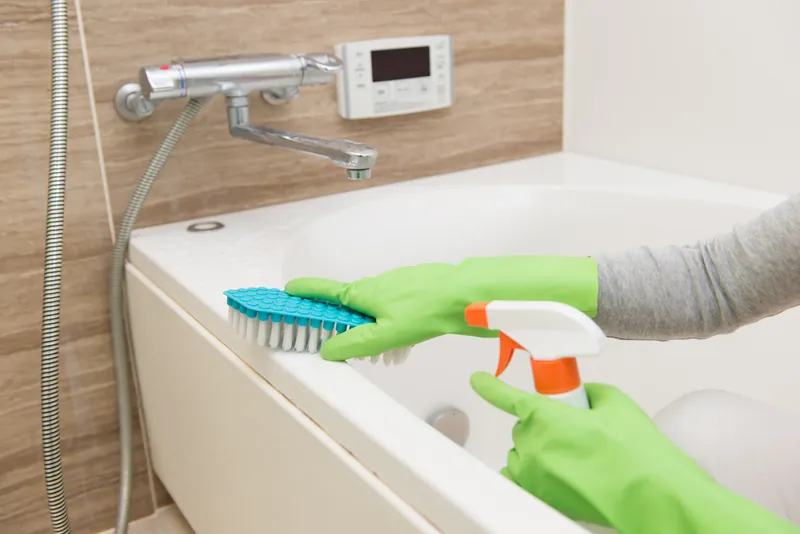
Do you scrub and scour yet still feel like your bathroom isn’t getting completely clean? Do grimy grout, mouldy caulk, and soap scum plague your shower and sink no matter how much elbow grease you apply?
Don’t despair – with the right techniques and a thorough step-by-step approach, you can tackle any bathroom mess.
When bathrooms aren’t cleaned properly, they become the perfect warm, moist environment for germs to multiply and wreak havoc. Bacteria, viruses, mould, and more can thrive and are waiting to infect you and your family.
You can turn your bathroom into a pristine germ-free oasis by routinely scrubbing away grime, eliminating mould, and banishing bacteria. This comprehensive guide will be your trusty blueprint for total bathroom sanitisation. You’ll discover why your family’s health depends on clean bathrooms, plus get our proven tips for how to clean a bathroom from top to bottom.
Get a FREE Brochure
Simply complete our form to see a full range of bathing solutions & their key features. It takes no time at all!
- How Bathroom Germs Affect Your Health
- Tips to Remember For Cleaning a Bathroom
- How To Best Clean Your Bathroom
- How to Disinfect a Bathroom
- Take Proactive Steps Toward Better Health
How Bathroom Germs Affect Your Health
Your bathroom is prone to harbouring a diverse array of potentially dangerous microbes. Without proper disinfection, bathrooms become the perfect warm, moist environment for pathogens to thrive and multiply.
You must stay vigilant about cleaning every inch of your bathroom to protect your family from illness-causing germs lurking on surfaces, fixtures, and in the air. Some of the most common bathroom germs include:
E. coli
- coli is found in faeces. If ingested, this bacteria can cause intestinal infections, urinary tract infections, respiratory illness, and pneumonia.
Salmonella
Salmonella is usually transmitted via contact with contaminated surfaces or food. It causes diarrhoea, fever, and abdominal cramps.
Norovirus
Also known as the “stomach bug,” norovirus is a highly contagious virus that spreads quickly in bathrooms. This nasty pathogen thrives in faeces and causes intense vomiting and diarrhoea in infected people.
Respiratory infections
Viruses like influenza, adenovirus, and rhinovirus spread through mucus and saliva droplets and thrive in humid bathrooms.
Athlete’s foot and plantar warts
These infections are caused by fungi and viruses that grow in warm, damp spaces like showers and locker rooms.
Mould
Excess moisture allows mould to grow, releasing spores that can cause allergic reactions and upper respiratory tract issues when inhaled.
Unfortunately, many types of harmful bathroom bacteria can survive for hours on surfaces, even after flushing and showering. With continual bathroom use every few hours in most households, these germs are never entirely eradicated.
The warm, moist conditions constantly reset the breeding ground, allowing populations to re-establish quickly.
Though we hope these risks don’t apply to you, many people are unaware of the unseen germ threats in their bathrooms. Regularly and thoroughly deep clean your bathroom to help mitigate exposure to these and other harmful microbes.
Tips to Remember For Cleaning a Bathroom
Before diving into the detailed cleaning checklist, here are some essential tips to remember when cleaning your bathroom:
- Declutter First – Remove clutter and organise supplies before cleaning. A decluttered space stays cleaner in the long run.
- Gather All Your Supplies – Prepare cleaning solutions, tools, and rags before starting. Avoid wasting time gathering supplies mid-clean.
- Start Dry, Finish Wet – Dust surfaces first before wet cleaning for easier scrubbing. Tackle dry dust before grimy, wet messes.
- Work Top to Bottom – Clean upper areas like counters and mirrors before lower areas like floors. This stops drips and dust from dirtying already cleaned zones.
- Prioritise Disinfecting – Reserve disinfectants for the highest germ zones, like the toilet bowl. Use all-purpose cleaners for most other surfaces.
Following these basic strategies will help streamline your bathroom cleaning process for faster, more effective sanitising sessions.
How To Best Clean Your Bathroom
Vigilant disinfecting is key since bathroom germs don’t disappear easily. Be sure to sanitise all surfaces. Stopping the cycle of constant bacterial growth requires thorough weekly cleaning and disinfecting.
Follow these tips on the best way to clean a bathroom from top to bottom:
- Clean the Air – Eliminate airborne pathogens by opening windows, running exhaust fans, using air purifiers, and spraying disinfectants.
- Scrub the Sink – Use a soft cloth, sponge, or brush to wipe away dirt. Disinfect surfaces with a bathroom cleaner or bleach solution. Don’t forget the tap, handles, and drain!
- Sanitise the Toilet – Scrub the bowl with a toilet brush and cleaner. Wipe the seat, lid, handle, and exterior surfaces with a disinfecting cleaner.
- Clean the Bathtub – Use a bathtub-specific cleaner or a mix of liquid soap, baking soda, and vinegar. Rinse and wipe away residue.
- Disinfect Knobs and Handles – These high-touch spots harbour germs: Disinfect doorknobs, the toilet handle, taps, and the shower/tub controls.
- Don’t Forget Walls and Floors – Apply bathroom cleaner or bleach solution to all walls, then scrub with a sponge or brush. Mop and disinfect floors, too.
- Take Out the Trash – Empty wastebaskets frequently and wash bins with soap and water to remove germ build-up.
- Replace Accessories – Discard, wash and replace old shower curtains, bath mats, and dirty accessories that harbour germs.
Create and post a bathroom cleaning checklist somewhere visible. Assign tasks to family members for shared accountability.
How to Disinfect a Bathroom
Cleaning your bathroom properly means using disinfectants and scrubbing tools proven to eliminate germs. We advise that you stock your cleaning closet with these supplies:
Multi-Purpose Cleaner
For most surfaces, an antimicrobial all-purpose bathroom cleaner works well for scrubbing and disinfecting. Look for EPA-approved products.
Bleach
For heavy disinfecting jobs, bleach solutions effectively kill dangerous bacteria and viruses. However, please take proper safety precautions when using these products.
Disinfecting Wipes
Wipes make cleaning small spaces fast and convenient. Keep a supply to quickly wipe down sinks, counters, knobs, and toilets.
Toilet Brush and Bowl Cleaner
Bowl brushes allow you to scrub away grime. Pick a cleaner made specifically for toilet bowls and tanks.
Grout Brush
Scrub mildew and stains from grout between tiles with a stiff-bristled grout brush. If you don’t have a grout brush, you can also use other soft bristle brushes.
Baking Soda and Vinegar
For a non-toxic cleansing option, white vinegar cuts grease, and baking soda naturally scrubs away stains.
Drain Cleaners
Monthly use of enzyme or chemical drain cleaners keeps drains free of buildup and prevents clogs.
Take Proactive Steps Toward Better Health
With this guide’s overview of the illness-causing pathogens that thrive in bathrooms, our goal is to create extra vigilance against these harmful microbes. Stay alert and take proactive steps to sanitise your bathroom thoroughly.
By arming yourself with the right tools and keeping up with regular bathroom cleanings, you can help protect your family’s health from the invisible germs that reside in your bathroom. Stay vigilant and take preventative action to sanitise your bathroom’s surfaces, fixtures, walls and floors for optimal hygiene.





